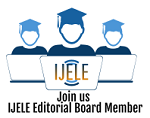(2) Sapriya Sapriya
(3) Rahmat Rahmat
(4) Iim Siti Masyitoh
(5) Siti Maizul Habibah
(6) Isnarmi Isnarmi
(7) Eni Kurniawati
*corresponding author
AbstractThis study aims to analyze and develop the Value Clarification Technique of Law (VCTL) learning model to strengthen high school students’ understanding of digital rights and responsibilities in Padang City. While students have the freedom to access internet technology, they are also expected to use it responsibly and respect the rights of others in digital spaces. The development of the VCTL model was motivated by the growing concern over students’ unwise behavior in using the internet, highlighting the need for an educational approach that fosters ethical awareness and value-based decision-making. This research adopts a Research and Development (R&D) methodology using the ADDIE model, which includes the phases of Analysis, Design, Development, Implementation, and Evaluation. The final product is a model book designed to assist teachers in implementing the VCTL approach in high school classrooms. The findings indicate that the VCTL model effectively enhances students’ digital responsibility by engaging them in structured value clarification processes anchored in legal and ethical considerations. The model encourages students to critically choose, clarify, and act upon values related to digital citizenship.
KeywordsLearning Model; Value Clarification Technique of Law (VCTL); Digital Rights; Responsibilities
|
DOIhttps://doi.org/10.31763/ijele.v6i3.2075 |
Article metrics10.31763/ijele.v6i3.2075 Abstract views : 93 | PDF views : 46 |
Cite |
Full Text Download Download
|
References
[1] M. Bialik, C. Fadel, B. Trilling, P. Nilsson, and J. Groff, “Skills for the 21st century: What should students learn,” Cent. Curric. Redesign, vol. 3, no. 4, p. 29, 2015.
[2] E. R. S. Laura L. Finley, “The Third Wave,” in Beyond Burning Bras, ABC-CLIO, LLC, 2010, pp. 31–40. doi: 10.5040/9798400617928.ch-003
[3] L. Poston, and J. Purdy, “Cabot Wright Begins,” Books Abroad, vol. 39, no. 2, p. 219, 1965, doi: 10.2307/40119710.
[4] M. Harizaj and V. Hajrulla, “Selecting and Developing Teaching/Learning Materials in EFL classes,” Ann. Philos. Soc. Hum. Discip., vol. 2, 2018.
[5] K. Mangal and N. Kurtdede Fidan, “Digital Storytelling Activities in the Course of Human Rights, Citizenship, and Democracy in Primary School,” Educ. Sci., vol. 47, no. 209, pp. 69–94, Feb. 2022, doi: 10.15390/EB.2022.10540.
[6] F. Tomasello, “From industrial to digital citizenship: rethinking social rights in cyberspace,” Theory Soc., vol. 52, no. 3, pp. 463–486, Jun. 2023, doi: 10.1007/s11186-022-09480-6.
[7] T. Wagner, “The Global Achievement Gap. Assessment.” pp. 20–21, 2014.
[8] G. Öztürk, “Digital citizenship and its teaching: A literature review,” J. Educ. Technol. Online Learn., vol. 4, no. 1, pp. 31–45, 2021.
[9] D. H. W. Sanjaya, Strategi pembelajaran berorentasi standar proses pendidikan. Jakarta: Prenada media, 2006.
[10] H. A. Althibyani and A. M. Al-Zahrani, “Investigating the Effect of Students’ Knowledge, Beliefs, and Digital Citizenship Skills on the Prevention of Cybercrime,” Sustainability, vol. 15, no. 15, p. 11512, Jul. 2023, doi: 10.3390/su151511512.
[11] M. Deflem, “The Right to Teach in a Hyper-Digital Age: Legal Protections for (Post-)Pandemic Concerns,” Society, vol. 58, no. 3, pp. 204–212, Jun. 2021, doi: 10.1007/s12115-021-00584-w.
[12] M. Hawamdeh, Z. Alt?nay, F. Alt?nay, A. Arnavut, K. Ozansoy, and I. Adamu, “Comparative analysis of students and faculty level of awareness and knowledge of digital citizenship practices in a distance learning environment: case study,” Educ. Inf. Technol., vol. 27, no. 5, pp. 6037–6068, Jun. 2022, doi: 10.1007/s10639-021-10868-7.
[13] C. Sullivan, “Digital citizenship and the right to digital identity under international law,” Comput. Law Secur. Rev., vol. 32, no. 3, pp. 474–481, Jun. 2016, doi: 10.1016/j.clsr.2016.02.001.
[14] L. Pangrazio and J. Sefton-Green, “Digital Rights, Digital Citizenship and Digital Literacy: What’s the Difference?,” J. New Approaches Educ. Res., vol. 10, no. 1, pp. 15–27, Jan. 2021, doi: 10.7821/naer.2021.1.616.
[15] J. S. Fernández-Prados, A. Lozano-Díaz, and A. Ainz-Galende, “Measuring Digital Citizenship: A Comparative Analysis,” Informatics, vol. 8, no. 1, p. 18, Mar. 2021, doi: 10.3390/informatics8010018.
Refbacks
- There are currently no refbacks.
Copyright (c) 2024 Rita Angraini

This work is licensed under a Creative Commons Attribution-ShareAlike 4.0 International License.

International Journal of Education and Learning
ISSNÂ 2684-9240
Published by Association for Scientific Computing Electronics and Engineering (ASCEE)
W : http://pubs2.ascee.org/index.php/ijele
E : zalik@ascee.org

This work is licensed under a Creative Commons Attribution-ShareAlike 4.0 International License.





















